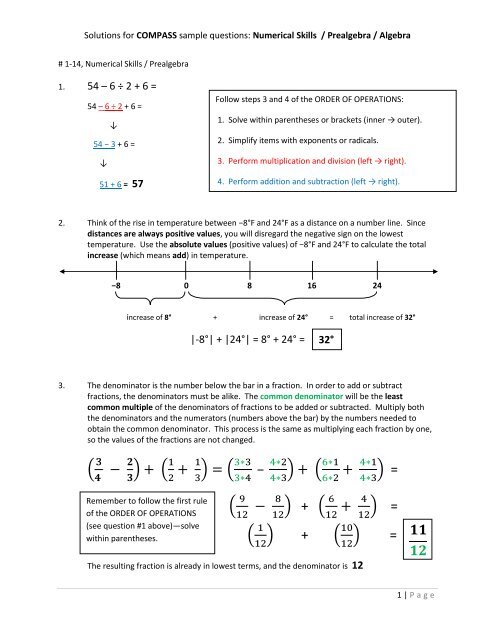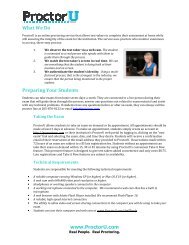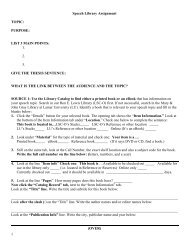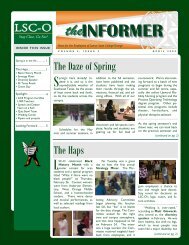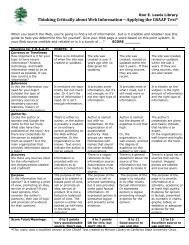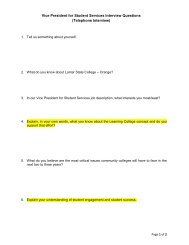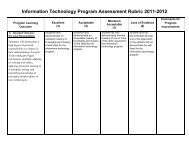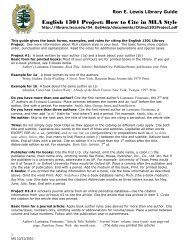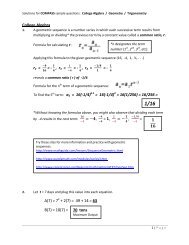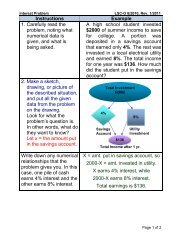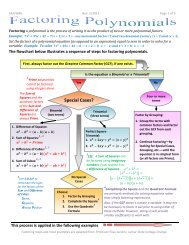Numerical Skills/Pre-Algebra Solutions
Numerical Skills/Pre-Algebra Solutions
Numerical Skills/Pre-Algebra Solutions
Create successful ePaper yourself
Turn your PDF publications into a flip-book with our unique Google optimized e-Paper software.
<strong>Solutions</strong> for COMPASS sample questions: <strong>Numerical</strong> <strong>Skills</strong> / <strong>Pre</strong>algebra / <strong>Algebra</strong><br />
# 1-14, <strong>Numerical</strong> <strong>Skills</strong> / <strong>Pre</strong>algebra<br />
1. 54 – 6 ÷ 2 + 6 =<br />
54 – 6 ÷ 2 + 6 =<br />
↓<br />
54 − 3 + 6 =<br />
↓<br />
51 + 6 = 57<br />
Follow steps 3 and 4 of the ORDER OF OPERATIONS:<br />
1. Solve within parentheses or brackets (inner → outer).<br />
2. Simplify items with exponents or radicals.<br />
3. Perform multiplication and division (left → right).<br />
4. Perform addition and subtraction (left → right).<br />
2. Think of the rise in temperature between −8°F and 24°F as a distance on a number line. Since<br />
distances are always positive values, you will disregard the negative sign on the lowest<br />
temperature. Use the absolute values (positive values) of −8°F and 24°F to calculate the total<br />
increase (which means add) in temperature.<br />
−8 0 8 16 24<br />
increase of 8° + increase of 24° = total increase of 32°<br />
|-8°| + |24°| = 8° + 24° =<br />
32°<br />
3. The denominator is the number below the bar in a fraction. In order to add or subtract<br />
fractions, the denominators must be alike. The common denominator will be the least<br />
common multiple of the denominators of fractions to be added or subtracted. Multiply both<br />
the denominators and the numerators (numbers above the bar) by the numbers needed to<br />
obtain the common denominator. This process is the same as multiplying each fraction by one,<br />
so the values of the fractions are not changed.<br />
– =<br />
Remember to follow the first rule<br />
of the ORDER OF OPERATIONS<br />
(see question #1 above)—solve<br />
within parentheses.<br />
+ =<br />
+ =<br />
The resulting fraction is already in lowest terms, and the denominator is 12<br />
1 | P a g e
<strong>Solutions</strong> for COMPASS sample questions: <strong>Numerical</strong> <strong>Skills</strong> / <strong>Pre</strong>algebra / <strong>Algebra</strong><br />
4. + =<br />
Solve within parentheses first.<br />
↓<br />
+ =<br />
↓<br />
↓<br />
+ =<br />
↓<br />
↓<br />
+ =<br />
↓ ↓ ↓<br />
Divide fractions by multiplying the numerator<br />
of the first by the denominator of the second<br />
and the denominator of the first by the<br />
numerator of the second.<br />
Multiply fractions simply by multiplying the<br />
numerators and denominators. Factors that<br />
are the same in the numerator and<br />
denominator cancel out.<br />
Find a common denominator. Then add /<br />
subtract numerators from left to right.<br />
+ =<br />
=<br />
5. Since the answer choices are decimal numbers, convert each quantity to decimal form and add.<br />
0 .75<br />
7 → 7 and 4 ) 3.00 → 7.75<br />
28<br />
20<br />
20<br />
0<br />
7.75 Line up decimal points.<br />
17.85<br />
+ 6.50 ← Use zero to hold hundredths place.<br />
32.10 total pounds of meat.<br />
0.5<br />
6 → 6 and 2 ) 1.0 → 6.5<br />
10<br />
0<br />
2 | P a g e
<strong>Solutions</strong> for COMPASS sample questions: <strong>Numerical</strong> <strong>Skills</strong> / <strong>Pre</strong>algebra / <strong>Algebra</strong><br />
6. First, divide the cost of a block of tickets by the number of tickets in the block to find the<br />
cost per ticket.<br />
16.00<br />
5 ) 80.00 Tickets are $ 16.00 each 5 ) 80 when purchased in a block of five.<br />
5<br />
30<br />
30<br />
0<br />
Then, subtract $ 16.00 from the cost of a ticket purchased individually to find the<br />
amount each student would save.<br />
18.50<br />
16.00<br />
2.50<br />
Each student would save $ 2.50.<br />
7. Scientific notation is a way of writing very large or very small numbers so they are<br />
easier to work with. A number expressed in scientific notation will be written as<br />
a decimal number between 1 and 10 multiplied by a power of 10.<br />
For more information, go to the Institute for Energy and Environmental Research at<br />
http://www.ieer.org/clssroom/scinote.html.<br />
20,000<br />
2.0<br />
4 3 2 1<br />
3,400,000<br />
340<br />
4 3 2 1<br />
Count the number of decimal places you must move to<br />
leave only one digit to the left of the decimal.<br />
The number of decimal places you moved is the<br />
exponent (or power) of 10.<br />
The number to be added must be multiplied by the same<br />
power of 10. That’s why we use 340 instead of<br />
3.40 .<br />
Rewrite answer with only one digit to the left of the<br />
decimal.<br />
2.0 + 340 = 342 →<br />
3.42<br />
2 1<br />
3 | P a g e
<strong>Solutions</strong> for COMPASS sample questions: <strong>Numerical</strong> <strong>Skills</strong> / <strong>Pre</strong>algebra / <strong>Algebra</strong><br />
8. 4 < < 9<br />
< ( <<br />
4*4 < ( * ) < 9*9<br />
16 < x < 81<br />
Square each term to remove the radical (square root symbol)<br />
and see the range of values for x.<br />
( = * = * = = = x<br />
Go to Interactive Mathematics at<br />
http://www.intmath.com/Exponents-radicals/Exponentradical.php<br />
to review the rules for exponents and roots.<br />
9. =<br />
6x = 72<br />
=<br />
Cross Multiply: Numerators X Denominators. Cross multiplication is<br />
used to find the unknown term of a proportion (two ratios—or<br />
fractions—that are equal). *If you do not see an = sign between the two<br />
fractions, do not cross multiply. Visit http://www.321know.com/g8-ratprop-crossx.htm<br />
for more practice with proportions.<br />
X = 12<br />
10. Let “cost of x apples” = b.<br />
Therefore,<br />
the “cost of each apple” = .<br />
*This is the unit price.<br />
Multiply the unit price by the<br />
new number of apples, y.<br />
Try out some actual numbers:<br />
Cost of 2 apples = 10 cents.<br />
Therefore,<br />
each apple costs 10 cents / 2 = 5 cents<br />
*This is the unit price.<br />
So, 3 apples will cost<br />
, or<br />
15 cents<br />
11. Let x = the total number of students in the class.<br />
Express 25% as a ratio, : , or .<br />
4 | P a g e
<strong>Solutions</strong> for COMPASS sample questions: <strong>Numerical</strong> <strong>Skills</strong> / <strong>Pre</strong>algebra / <strong>Algebra</strong><br />
Set up a proportion, letting x represent the total number of students.<br />
=<br />
= Cross multiply to solve for x:<br />
x = 48 Total Students<br />
12. 75% had taken at least 8 ( 8 or more ) math courses.<br />
Percentage of remaining class members = 25% (100% − 75%).<br />
6o% of the 25% had taken 6 or 7 math courses.<br />
“Of” means multiply.<br />
60% (25%) = 15%<br />
Had taken 6 or 7<br />
math classes.<br />
.60<br />
* .25<br />
300<br />
120<br />
.1500 = 15%<br />
Move decimal right two places.<br />
75% + 15% = 90% of students had taken at least 6 ( 6 or more ) math classes.<br />
Subtract 90% from the whole graduating class to find the percentage of students that<br />
had taken fewer than 6 math classes:<br />
100% − 90% = 10%<br />
13. Let x = the sum of all test scores.<br />
Average is calculated by dividing the sum of all scores by the number of scores.<br />
Set up an equation for average and solve for x: = 84<br />
Multiply both sides of the equation by 6: = (84)6 , x = 504<br />
Divide 504 by 7 tests:<br />
504 / 7 = 72 average<br />
5 | P a g e
<strong>Solutions</strong> for COMPASS sample questions: <strong>Numerical</strong> <strong>Skills</strong> / <strong>Pre</strong>algebra / <strong>Algebra</strong><br />
14. Let x = the sum of the juniors’ test scores.<br />
Set up an equation and solve for x: = 80 , 35 = (80)35<br />
Let y = the sum of seniors’ test scores.<br />
X = 2800<br />
Set up an equation and solve for y: = 70 , 15 * = (70)15<br />
y = 1050<br />
Sum of test scores for all 50 students = x + y = 2800<br />
1050<br />
3850<br />
To find the average for all 50 students, divide sum of test scores by 50.<br />
77<br />
3850 / 50 =<br />
50 )3850<br />
350<br />
350<br />
350<br />
0<br />
77 avg.<br />
6 | P a g e


